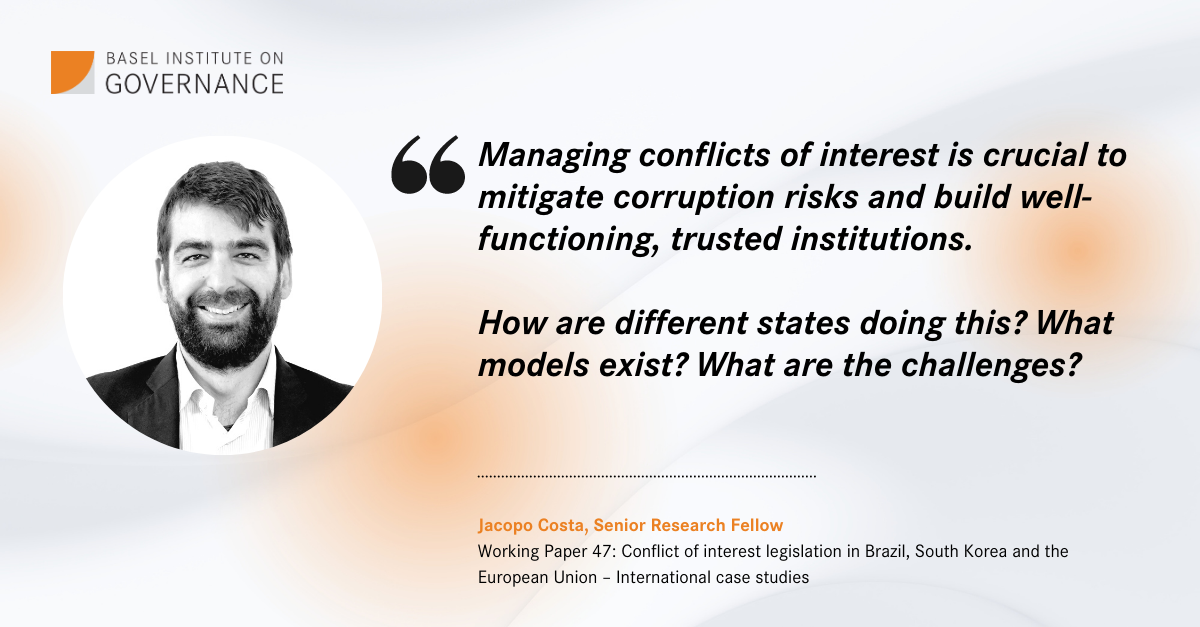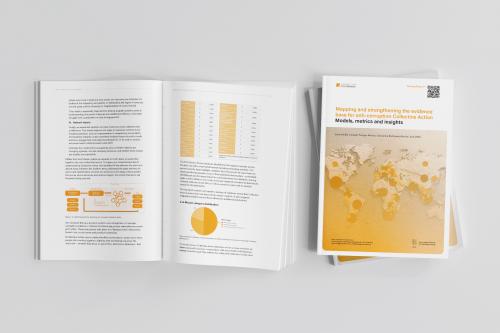Managing conflicts of interest in the EU, South Korea and Brazil – new study

Effectively managing conflicts of interest in the public sector is crucial to mitigate corruption risks. It is also fundamental to building well-functioning institutions and to generating trust in government. How are different states doing this? What models exist? What are the challenges?
To answer these questions, our new report analyses conflict of interest legislation and management in three case study contexts: South Korea, Brazil and the European Union.
The three case studies share, to varying degrees, democratic regimes, competitive elections and advanced economic performance. At the same time, they differ in the shape of their institutional architecture, spanning a fairly centralised system (South Korea), a federal state (Brazil) and a supranational entity (the EU).
The study is based on the international standards in the 2020 guide Preventing and Managing Conflicts of Interest in the Public Sector, produced by the World Bank Group, OECD and UNODC at the request of the G20 Anticorruption Working Group.
It was prepared under the USAID Indonesia Integrity Initiative (USAID INTEGRITAS). We hope it will be valuable to anyone interested in drafting, revising or monitoring conflict of interest legislation in any context. Here are some key takeaways:
Similar in principle…
Developing mechanisms to manage conflicts of interest is recognised as crucial for good governance in all three contexts – even if building a conflict of interest management system is not per se a guarantee of eradicating it.
The three systems are based on a shared idea of what it means to prevent and manage conflicts of interest. Common elements include:
- mechanisms for reporting financial interests, properties and personal relations;
- remedial actions for managing conflict of interest situations and administrative and penal sanctions for punishing violations;
- thresholds and prohibitions for gift giving and hospitality;
- protocols for managing post-employment terms and revolving doors mechanisms.
The level of specificity of the legal framework matters. Higher specificity clarifies what is permitted and not, as well as the consequences for violating the law. However, a very broad, detailed and demanding law might be challenging to enforce in complex bureaucracies. A proper balance needs to be found.
…different in practice
Despite the underlying similarities, the systems look quite different in each case study context.
This happens when international standards enter into contact with the functional, operative and informal characteristics of different social, political, bureaucratic and business environments. Differences in the institutional architectures of the three contexts have also impacted the characteristics of the systems aimed at managing conflict of interest situations.
Another difference concerns the origin of legal frameworks on conflicts of interest. For example, South Korea built its conflict of interest infrastructure ex novo after corruption scandals emerged. Meanwhile, Brazil has built its system on top of solutions already developed in the early 1990s for regulating the duties of politicians and bureaucrats. Both of these strategies have pros and cons:
- Starting from zero allows legislators to build a conflict of interest framework that integrates the most innovative solutions. But there is a need to train public officials to follow the new practices, push against the pressure of doing business as usual, and instil new preferences in the bureaucracy.
- Building on pre-existing laws and regulations can be a resource-saving strategy. But there is a risk of duplication or overlapping of functions and mandates, as well as legal opacity and unnecessary red tape due to excessive cross-referencing with previous acts or codes.
Differences between the contexts are also visible in the harshness of the penal and administrative sanctions. The South Korean model imposes very strong sanctions, such as several years of imprisonment in the most serious cases. Implementation of these penalties also appears to be severe in contrast to the Brazilian and EU models.
Implications
The findings from the analysis underline how critical it is to build a flexible, adaptive and proactive policy-making approach to regulating these sensitive issues. Policymakers and legislators must also be able to integrate input and feedback from citizens and the business community to continuously update their legal infrastructures.
In addition, the analysis reveals:
- It is not enough to define vague procedures to address situations of conflict of interest; specificity is also necessary. At the same time, adding too many details risks generating issues with implementation of the law for enforcers and investigators.
- The severity of the sanctions is a critical deterrent and preventive factor, as well as a key support for enforcement and investigative activities. This has to be balanced with respect for the rule of law and human rights.
- A minimum common ground is helpful for conflict of interest legislation, at least touching all points in the Preventing and Managing Conflicts of Interest in the Public Sector guide. But specific technical solutions need to be tailored to the local context.
- Incrementally reforming and amending existing frameworks for conflict of interest can result in a fractionalised architecture with mutually incoherent pieces, such as disconnected or duplicative acts, regulations and codes of conduct. It is helpful to try to build the infrastructure around one major piece of legislation and align the rest around it as best as possible.
- Robust systems and protocols must be in place to handle the complexity of managing conflicts of interest. This needs investment in both institutions and governance capacity, but also functional rationalisation to avoid overly bloating the bureaucracy.
- A risk-based approach is needed to prioritise the greatest risks of conflict of interest, identify areas that deserve more attention and ease effective implementation of the management system. This means using tools to assess the risks of corruption and conflict of interest along the governance chain.
Addressing gaps – campaign financing
A key conflict of interest pattern behind grand corruption schemes involves connections between electoral campaign financing by particular business interests and subsequent decisions on the award of valuable public contracts. It is noteworthy that such issues are not adequately covered by the legal and regulatory frameworks described in this report.
Very often, data collected on the financing of the electoral campaigns is not used to detect and red-flag suspicious connections between electoral financial flows and the subsequent distribution of public contracts and procurements. Matching data on electoral financing and public procurement procedures with the goal of revealing suspicious situations could contribute to improving the prevention of one of the most pernicious forms of conflict of interest.
Legislating more closely how electoral donations must be reported and made transparent would be a step in the direction of addressing some of the most important conflict of interest and, ultimately, corruption risks.
Investing in innovation
The analysis shows the challenge – and opportunity! – to make productive use of the huge amount of data generated by public systems. This includes data on public officials’ financial assets, real estate and social relations, as well as data from land, property or vehicle registers, campaign finance transactions, procurement transparency systems and beneficial ownership registers. Connecting these would be a good start.
Going forward, new and better data management solutions are crucial for effective implementation of conflict of interest management systems and other anti-corruption measures. Designing artificial intelligence or machine learning tools to mine data and cross-reference databases to red-flag suspicious connections and exchanges should be in the research agenda going forward. The generation of high-quality and comparable databases is a goal that must be further emphasised.



